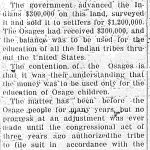November 3, 1922
Osage County News
Microfilm Roll: MN00305
On this day in Osage country, the Osage County News published an article about a law suit being brought against the United States government buy the Osages.
The Canville Treaty was an agreement between the United States government and the Osage tribe pertaining to the cession and sale of Osage lands in the state of Kansas. Supposedly, the agreement was to pay the Osages $300,000, as the Osage understood it, for 1,500 square miles of their land. The profit from the land sale was to be placed in, what was later termed, the “civilization fund” for the purpose of educating and civilizing the Indians. However, the treaty never specifically states that the Osage were to be the beneficiaries of this money. Instead, the document states that “no part of such ceded lands shall be appropriated to Indians not on friendly relations with the party making the cession,” (Burns, 282). The Osages were not considered to be on “friendly terms” with the ones responsible for the cession. In total, the Osages ceded nearly 900,000 acres of their land in Kansas which meant that nearly $800,000 were to be placed in the civilization fund. Ultimately, however, the Osages received less than 1% of the money, while the rest was divided between both friends and enemies of the tribe.
According to the article, the Osages were suing the government of the United States for not complying with their side of the agreement, which was to provide the Osages with educational funding to build Indian schools; the funding of which was agreed upon under Canville Treaty. The Osages believed that this money was to be set aside for the education of Osage children in particular, however, the money was used to build boarding schools that serviced Indian children from nearly all tribes except for the Osage tribe. Many of the well-known Indian boarding schools were built with this funding, including the Carlisle Indian Industrial School in Pennsylvania, Hampton Institute in Virginia, and the Haskell Institute at Lawrence, Kansas, among others.
Although, the Osages made several attempts to claim the money that was owed to them, it was not until the 1920s that any progress was made. This progress began with the “congressional act of [1919 which] authorized the tribe to file suit,” which was then followed by actions discussed in this article (Civilizing).
Morgan M. Guzman
“Civilizing the Osages Costly.” Osage County News. November 3, 1922, p. 1. Microfilm roll number MN00305. Sequoyah National Research Center, Little Rock, Arkansas.
Further Reading
Burns, Louis F. A History of the Osage People. Tuscaloosa: University of Alabama Press, 2004.
Source File(s)
Related Stories
- Osage and Quapaw Get Their Freedom by Sells’ Order
- Discussion of Government Control of the American Indian by Congressmen
